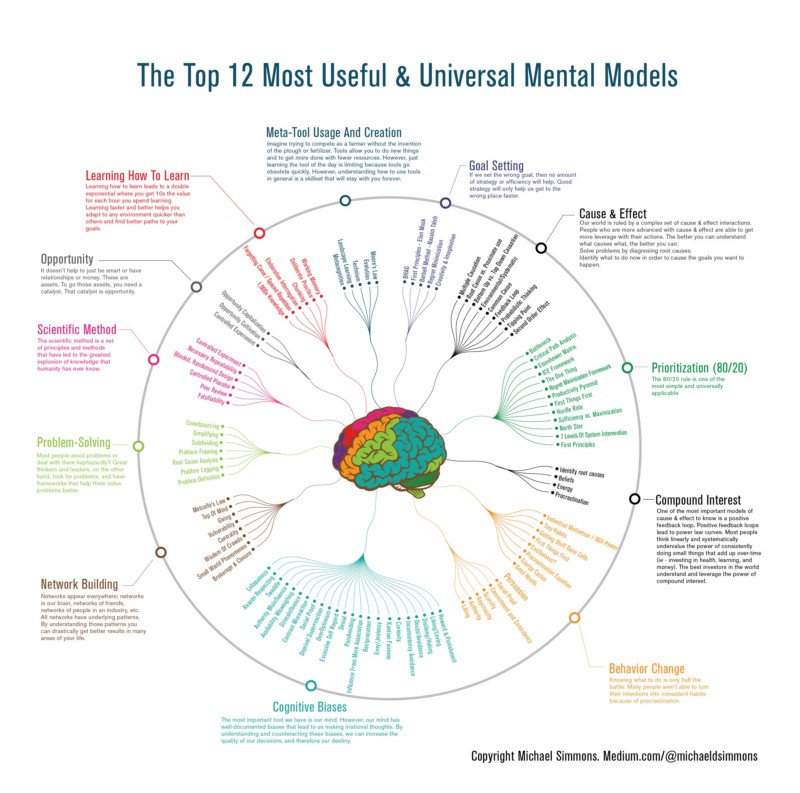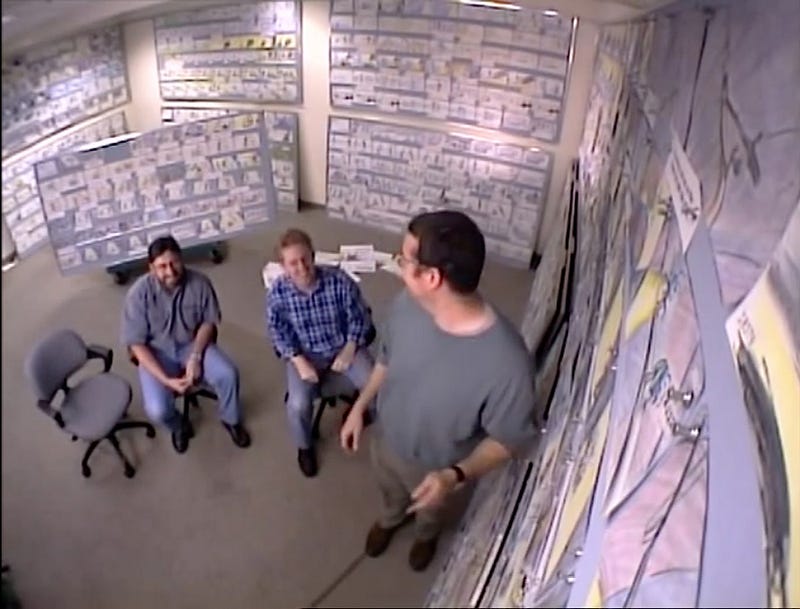This Is Exactly How You Should Train Yourself To Be Smarter [Infographic]
View the high resolution version of the infographic by clicking here.
Out of all the interventions we can do to make smarter decisions in our life and career, mastering the most useful and universal mental models is arguably the most important.
Over the last few months, I’ve written about how many of the most successful self-made billionaire entrepreneurs like Ray Dalio, Elon Musk, and Charlie Munger swear by mental models…
“Developing the habit of mastering the multiple models which underlie reality is the best thing you can do.”
— Charlie Munger
“Those who understand more of them and understand them well [principles / mental models] know how to interact with the world more effectively than those who know fewer of them or know them less well.”
— Ray Dalio
“It is important to view knowledge as sort of a semantic tree — make sure you understand the fundamental principles, i.e. the trunk and big branches, before you get into the leaves/details or there is nothing for them to hang onto.”
— Elon Musk
Each of these luminary entrepreneurs use different words to essentially say the same thing.
I’ve collected the 650+ most useful mental models from the best mental model curators in the world. It is now the most comprehensive list in the world. And I’ve launched a free mental model mini-course to help you understand what a mental model is and how to apply it to your life.
This infographic is the culmination of all these articles. It is my personal list of the 12 most useful & universal mental models that I believe everyone should master first. For each mental model, I share the sub mental models that make it up and one paragraph explaining its significance.
This infographic matters because it would take 6,500 hours to master each of the 650 mental models that others have recommended. That’s a lot of freaking time! You probably aren’t ready to commit that amount of time to mental models… yet. By creating this infographic, I hope to save you dozens of hours determining which models to learn first.
If you’re interested in learning these models so you can use them automatically whenever you need them in order to make better decisions, then keep reading…
What Are Mental Models?
Mental models are descriptions of reality that apply across every area of our life, don’t get outdated, and provide immediate results by helping you make better decisions.
They are like little miniature mental maps of how a particular area of life works.
And when you learn them, it changes everything.
What Is An Example Of A Mental Model?
One of the most famous mental models is called the Pareto Principle. You probably know it as the “80/20 rule.” This mental models says that most of your results are going to come from just a small percentage of your effort or work.
Vilfredo Pareto, the man who discovered this principle noticed that 80% of the land in his area was owned by 20% of the people. He looked in his garden, and saw that 80% of the peas were in 20% of the pea pods. Then he realized that this was something like an organizing principle of life.
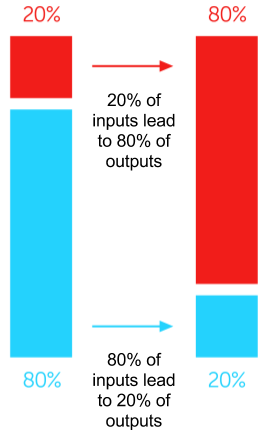
This phenomena applies across many domains including productivity, happiness, business, health, etc. Here are a few examples:
- 20% of relationships lead to 80% of happiness.
- 20% of exercises lead to 80% of health benefit.
- 20% of items on your to do list lead to 80% of productivity.
For example, by taking 30–60 minutes per day for prioritization, you can double your productivity. By auditing the relationships in your life, you can identify people you want to spend more time with and people you want to remove from your life. By looking at what experiences give you the most delight, you can begin to engineer your life differently.
The rule can also be inverted:
- 20% of relationships cause 80% of drama.
- 20% of clients cause 80% of the problems.
- 20% of foods you eat cause 80% of your sickness.
This model is much more complex and it can be applied to infinitely more places, but this basic version allows you to quickly get value from it.
Use Mental Models to learn faster, get smarter, make better decisions, be more creative, grow your business & career, and succeed in life…
- Have you been feeling information overwhelm lately, a new flood of information, that’s growing every single day? How do you find and learn the most valuable knowledge, especially when you’re busy with your career, business, family?
- Have you ever felt like you never have enough time or energy to learn? Do many of the books that you purchase end up never being read? How do you find time to learn when you’re busy with a career and family?
- Have you noticed how easy it is to forget what you read (after just a few days)? The question is: How can you apply the knowledge you learn to your life so that it’s there for you automatically, whenever you need it?
- Have you noticed that decisions in life are becoming more complex? How do you make better professional and personal decisions (when there is so much change and uncertainty)? How do you identify the 1% of activities that will give you 90% of your results? And how do you make decisions that you won’t regret later and that have the highest chance of success?
On a fundamental level, these questions get at the three keys of becoming a mental powerhouse:
- Learning faster
- Thinking better
- Making smarter decisions
And until now, there hasn’t been an organized tool-kit that you can learn and use for this.
My name is Michael Simmons, and my favorite thing to do in the world is to learn, apply what I learn to get a result, and then teach others so they get the same result. That’s why, throughout my whole career, I’ve read thousands of books and started education companies that have generated millions of dollars in revenue and impacted millions of people.
In addition to being an entrepreneur, I have written dozens of articles on learning for Forbes, Fortune, Time, Inc., Entrepreneur. I’ve built one of the biggest learning how to learn communities in the world (54,000+ people). Finally, I’ve created a Learning Ritual Course with hundreds of happy students who I’ve personally coached.
More recently, I’ve pioneered a learning system for professionals and entrepreneurs — which I have taught to nearly one thousand people around the world, which has helped me generate millions of dollars in business as an entrepreneur, and which has helped me build a Learning Lifestyle where I essentially get paid to spend most of my time learning, and where I get paid for my insights rather than my time.
In a moment, I’ll explain my “thinking tools” that will help you unlock the next level of success in your business and career.
I’ll also invite you to join me in an exclusive group of nearly 1,000 professionals from around the world who are using these tools to learn faster, improve their lives and succeed in business.
Successful entrepreneurs are using these tools to start and grow businesses, get more customers, make more profit. Investors use them to get higher returns. Thought leaders, consultants, and coaches use them to create original ideas, innovations, and valuable knowledge.
How I Discovered The Power Of Learning & Using Mental Models In Business & Life

“Will this article be read by anyone?”
That was the #1 question going through my mind as I pressed ‘Publish’ on my first Forbes article in April of 2013.
As someone with no email list or journalism background, my insecurity felt overwhelming. I feared my words would just be buried in the Internet’s sea of content.
In college, I had written hundreds of blog posts with the dream of becoming a writer, but things fizzled, and I feared the same thing would happen again. I knew what it felt like to be a mediocre writer.
So, I made a crucial decision…
Rather than just jumping in and making the same mistakes, I would take a step back and deliberately learn how to be a great writer.
Around that time, I stumbled upon and read Poor Charlie’s Almanack.
This turned out to be the one book that changed my life.
Written by a self-made billionaire and Warren Buffett’s longtime business partner, this was the first book to introduce me to mental models, and I immediately saw their power.
Mental models are descriptions of reality that apply across every area of our life, are always relevant, and provide immediate results by helping you make better decisions. They are like little miniature mental maps of how a particular area of life works. And when you learn them, it changes everything.
Two quotes from Charlie Munger, in particular, inspired me to start learning the best mental models in the world:
You can’t really know anything if you just remember isolated facts and try and bang ’em back… You’ve got to have models in your head… You may have noticed students who just try to remember and pound back what is remembered. Well, they fail in school and in life.
You’ve got to hang experience on a latticework [integrated collection] of models in your head. Fortunately it isn’t that tough because 80 or 90 important models will carry about 90% of the freight in making you a worldly wise person. And, of those, only a mere handful really carry very heavy freight.” — Charlie Munger
More specifically, these quotes inspired me to search out the world’s most successful article writers, interview them with the goal of uncovering their top mental models, and apply them to my own writing.
BOOM! Suddenly, my entire reality changed.
From the first article, my writing took off. Each article I wrote had over 10,000 people — the equivalent of a small stadium — read it.
As I “installed” more mental models in my brain, I became a better writer, and the audience increased from 10,000 per article to 50,000 to 100,000 to 200,000 today.
Eureka!
One night, I literally jumped on my couch like a little kid, elated that I was finally finding success and impact after so many years of struggle. The feeling of figuring out a secret formula and seeing it work over and over was exhilarating.
And the more I studied and wrote about mental models, the more I naturally started to use them in my life and business outside of writing, and the better results I got. This was a game-changer for me.
Here is one of the mental models that was particularly helpful…
The True Power Of The 80/20 Rule
Here’s another example of the 80/20 Rule: You’ve probably read that top venture capitalists make most of their big returns on just a few of their investments. It only takes one Google, Facebook or Uber investment to make you a billionaire investor.
Top Poker players earn most of their money winning just a few big hands. The key for them is to know which hands to bet big on, and which to walk away from. The key for them is to know which hands to bet big on, and which to walk away from.
This Principle Seemed To Work Everywhere
As I studied the 80/20 Rule, and applied it to my own life, I started to see the places where I could put just a little bit of effort, and get much bigger results.
One big example was how it changed my approach to relationships. Before, I had been going to lots of conferences and networking events, and basically trying to “meet everyone” in the world. I always felt a bit behind, and like I was constantly trying to fit in.
After I understood the 80/20 Rule, it gave me permission to focus on the few people in my life that really mattered. I focused on a handful of people I resonated with the most, and I concentrated on building deeper, more meaningful relationships. This really changed the game for me. By focusing, I not only learned more and got a lot more happiness, I also was able to develop deeper ties to some very influential and successful people. And again, it took me a lot less time!
When I applied the 80/20 principle to learning, this created a real paradigm shift for me. Nowadays, when I decide to study a new skill or area, I’ll buy maybe 10 or so books on the topic. But my mindset is to look for the ONE book that is the best “explainer” — and then to focus most of my effort on that one book. This gives me mental permission to “abandon” the books that aren’t as good, and dedicate my precious attention to only the higher-quality knowledge.
And again, this brings me much better results, in a fraction of the time. The 80/20 Rule provides way more leverage than simply working harder. We are all limited by the number of hours in a day and how much our bodies can handle, but when it comes to applying the 80/20 Rule, there are opportunities for 1,000 times the leverage!
In my work as a writer, the 80/20 Rule installed the mindset to focus on only those few key things that really mattered. In the past, I put all of my effort into writing books and articles. After learning about the 80/20 Rule, I started asking other writers what the 80/20 was for them. Very quickly, I saw that everyone mentioned that titles were a key to success. Previously, I viewed the titles as just an afterthought.
So now I have a system where our team dedicates 5 hours per article creating new innovative words and terms, and also testing the titles of the articles before publishing them. What a big difference this has made!
I wrote one article recently, using my mental models as the framework, and I basically created something that was “designed to win.” The result? A million people read it.
A Powerful Secret Mental Weapon
The more that I learned and used mental models in my thinking, decision making, writing, business… and personal life… the more I realized that I had discovered a secret mental weapon.
I was using thinking tools that most other people hadn’t discovered, and I was getting much better results in life. From bringing in new clients, to generating investment capital, to having a happy family, these new mindsets and mental tools were giving me a huge advantage… and amazing results.
I now had a systematic way to approach business and life. And it worked.
The results I was getting weren’t just a little better. This wasn’t a little 5 or 10% change. It wasn’t even a 100% improvement. This was 10x, and in some cases 100x. It was a big deal.
Then I Put It To The Real Test
After discovering and using mental models in my own life, I started teaching them to friends and clients. I also started using them when doing projects for other companies.
I used it with one client who had almost no audience. No readers, no shares, no viral success. I used my mental models to help them write an article, and they got 30,000 views on the first article, and then it started to go viral. I did the math, and this was 175x better results than they had ever gotten before.
Another article I helped another client in another industry write had 100,000 readers and 20,000 shares.
I helped write something for a client on Quora, and it went crazy and got a million readers.
Another client wanted to use article writing to generate sales leads and customers, and the article we wrote got a half a million views, and made them $100,000 in sales very quickly.
These models were working everywhere I tried them.
Because of my success with articles, I also had people hire me for six-figure consulting contracts. I began charging $250-$500 per hour as a coach and consultant. I even got a five-figure speaking gig from an article.
And today, when I write articles myself, they are read hundreds of thousands of times on average, and they almost always go viral. It’s a system. I have a set of mental models that I use, and they work.
Once I really understood mental models, and how powerful they were, I made a commitment to learning them for the long-term. I knew that I had discovered THE shortcut to getting better at anything in life quickly.
Of course, once I realized this, I wanted to learn everything I could about mental models. So I went online and started researching mental models, reading books about them, and finding experts who understood them.
What I Found Actually Surprised Me…
There were almost no good books about mental models! Charlie Munger’s book got me interested in mental models, but it was a unique gem. Almost no one else was writing about them.
And when I searched online, I found a handful of people who were interested in models. They typically had a big list of mental models that were important to learn — but they didn’t explain the models, how to use them, and how to apply them.
Because mental models were so important, I realized that I was going to need to roll up my sleeves, and figure this out for myself. I couldn’t believe it, but there just wasn’t a systematic way to learn the most important mental models for success in business and life.
So I began reaching out to experts who understood mental models, making friends with people who used them, and generally trying to hack into this domain. I even co-hosted a mastermind with a bunch of PhDs and other experts from different domains who were all experts with mental models.
As I did this, I made lists of hundreds of different mental models from different domains. I wanted to identify the most important mental models, learn them, and then start using them in my life. (And because I knew the 80/20 Rule, I already knew that it was going to be a small number of models that really made the difference — which turned out to be correct.)
Over the past few years, I have now identified what I consider to be the most valuable and useful mental models in business and life. And more importantly, I’ve started teaching them to a serious group of thought leaders, entrepreneurs, investors, and other professionals.
Introducing The Mental Model Of The Month Club
If you’re starting to understand the power of mental models, and you’re ready to go to the next level and learn the most important mental models to create success in your life, then I’d like to invite you to join our Mental Model Club.
Inside, every month you’ll learn one of the most important mental models and how to apply it to your life — in just 1–2 hours per month.
The Mental Model Club is an online course, community, and membership that teaches you the most valuable and useful mental models. We have almost 1,000 members from around the world, and we’re growing fast.
Inside the Mental Model Club, you’ll…
- Learn key mental models that are most critical for professional success (without feeling overwhelmed by all of the distracting information out there)
- Automatically apply mental models in your professional and personal life, without having to remember what you learned
- Use the right mental model in the right situation every time, so that you can think faster, smarter, make better decisions, get the results you want
- Avoid painful thinking and decision-making mistakes that set us back (most people aren’t even aware of these, because they are so hidden inside their minds)
Here’s What You Get Every Month…
✔ Your Mastery Manual

Every month, you receive one mental model in the form of a high-quality, comprehensive guide. I call it your Mastery Manual.
It’s the most condensed, in-depth explanation of any mental model that exists in the entire world. We take the best of what’s ever been said about the mental model, cut out all of the fluff, and organize it in a way that is easy and fast to learn.
In each Mastery Manual, you learn…
- A 101 Overview of the mental model (why it’s important, how it works, vocabulary, etc.)
- An advanced overview to give you the high-level summary, then an in-depth report that includes a more nuanced explanation
- Examples, tricks, and hacks you can use to apply the mental model to every area of your life and career
- Exercises, resources, & templates that you can use on a daily basis to integrate lessons in the manual and get results in your life.
✔ Your Monthly Masterclass
To help you learn your mental model knowledge faster, you also get a high quality, pre-recorded masterclass of the month’s mental model.
The monthly masterclass is deliberately designed as a standalone resource, so that you can get value right away — well, in just one hour of listening to it.
Here’s what you get in each pre-recorded masterclass:
- Concise “80/20” overview of the mental model: To help you understand and apply the mental model on a deeper level, I explain the most important ideas.
- Walkthrough of mental model exercises: I handpick exercises in the Mastery Manual, and coach you on using them.
- My answers to other Mental Model Club members’ questions: These are often common questions that people have about the mental model.
What Mental Model Club Members Are Saying…
“As a self-taught entrepreneur who has built five organizations (which employ over 60 people) on transforming education to include character building and skill development, I am blown away by the content in the Mental Model Club. Having read hundreds of books, without a doubt, it provides the most comprehensive training on mental models in the world. As an educator, I think we should be teaching everyone about mental models and, I’m impressed by Michael’s approach to teaching it.”
— Tijl Koenderink, Entrepreneur
“I’ve been a teacher, trainer, administrator and ultimately am an entrepreneur. I have been learning more from the Mental Models than anything else in my recent memory. The mastery manuals articulate concepts in a way that not only filled in my knowledge but gave me much better language to explain the concepts to others. The Mental Model Club provides actionable insights for a very reasonable price. I am enjoying being the first of my friends to recommend the club as it makes me feel smarter than everyone else who hasn’t found it yet.”
— Juliet Mee, Teacher, Trainer, Administrator, Entrepreneur
“I joined the Mental Model Club, so I could experience faster rates of growth in my personal life and career. The biggest benefit I’ve had from being a member so far is realizing how little of my potential I’m using and how much more I’m capable of. As a result of the 80/20 module I’ve 80/20’d my morning routine, what used to be a stressful anxiety inducing experience is now the cornerstone of me having an excellent day and has become a keystone habit. As a result of the goal setting module, I’m now enjoying a higher quality of life by spending more time in nature and more time with my wife. In a sea of intellectual mediocrity and information overload, the Mental Model Club is my 80/20 cubed of gaining actionable insight I can get to make real traction in my life.”
— David Pita, Project Manager, Digital Agency
“I joined the Mental Model Club just a month ago and not only my clarity has skyrocketed, since I no longer need to read a lot of books and lots of info. Because I know understand the mental models and thought processes behind them. Thanks to this club too, my business decisions are 10X better because I use the mental model checklists provided. As I scale to 7-figures this year this club is a must have for me. It keeps my thinking and mindset straight as I face some of the problems that come with scaling up.”
— Sergio Estevez, Entrepreneur
Try The Club Now For Just $1
As you become more successful in life, you have to do different things to get to the next level.
You can keep using trial & error, building your knowledge on a potentially shaky foundation. Keep risking making mistakes in your career, business and life.
OR
you can get it right the first time, by investing in the Mental Model Club today.
When you register now, you’ll start by learning what we consider to be the most powerful mental model. You get a Mastery Manual and implementation exercises.
In less than an hour, you’ll be making better decisions, understanding the world better, and making better predictions and estimates about what’s going to happen.
Give Mental Model Club a try now:
Forget About The 10,000-Hour Rule. Thomas Edison, Jeff Bezos, And Mark Zuckerberg Follow The 10,000-Experiment Rule
Most people think that Edison invented the first light bulb.
They’re wrong.
In fact, Edison was spectacularly late to the game.
In 1878, when the 36-year-old inventor decided to focus on building a light bulb, 23 others had already invented early versions called arc lamps, some of which were being used commercially to light streets and large buildings.
So how did Edison win in such a crowded field when he was so far behind?
He and his team spent a year working day and night doing thousands of experiments. On October 21, 1879, they succeeded, creating a light bulb for everyday use in the home.
Edison would go on to pioneer five different multibillion-dollar fields with his invention factory: electricity, motion pictures, telecommunications, batteries, and sound recording. In today’s terms, you can think of Edison as Elon Musk, Jeff Bezos, and Mark Zuckerberg all rolled into one.
What was the key to Edison’s incredible success? In two words — deliberate experimentation. For Edison, building a company was synonymous with building an invention factory.
The technique is just as powerful today. “Our success at Amazon is a function of how many experiments we do per year, per month, per week, per day,” Jeff Bezos has claimed. In a recent interview, Mark Zuckerberg explained, “One of the things I’m most proud of that is really key to our success is this testing framework … At any given point in time, there isn’t just one version of Facebook running. There are probably 10,000.”
Bezos and Zuckerberg aren’t saying that experimentation is one of many strategies. They are saying it is THE strategy. In this article, you’ll see how luminaries across many fields use deliberate experimentation and how you can use it to increase your odds of success in your professional and personal life.
Why 10,000 Experiments Beat 10,000 Hours
Perhaps the most popular current success formula is the 10,000-hour rule popularized by Malcolm Gladwell. The idea is that you need 10,000 hours of deliberate practice to become a world-class performer in any field.
Research now tells us, however, that this formula is woefully inadequate to explain success, especially in the professional realm. A 2014 review of 88 previous studies found that “deliberate practice explained 26% of the variance in performance for games, 21% for music, 18% for sports, 4% for education, and less than 1% for professions. We conclude that deliberate practice is important, but not as important as has been argued.”
This chart summarizing the results should cause any ardent believer in the 10,000-hour rule to pause:
Via Deliberate Practice and Performance in Music, Games, Sports, Education, & Professions: A Meta-Analysis
This means that deliberate practice may help you in fields that change slowly or not at all, such as music and sports. It helps you succeed when the future looks like the past, but it’s next to useless in areas that change rapidly, such as technology and business.
What Edison and others (see more examples below) teach us is that we should maximize the number of experiments, not hours. Instead of the 10,000-hour rule, we need what I call the 10,000-experiment rule.
Throughout history, the scientific method has arguably produced more human progress than any other philosophy. At the heart of the scientific method is experimentation: develop a hypothesis, perform a test to prove the hypothesis right or wrong, analyze the results, and create a new hypothesis based on what you learned. The 10,000-experiment rule takes this proven power of experimentation out of the lab and into day-to-day life.
Following the 10,000-experiment rule means starting your day with not just a to-do list but a “to-test” list like Leonardo Da Vinci. According to Walter Isaacson, one of Da Vinci’s biographers, “Every morning his life hack was: make a list of what he wants to know. Why do people yawn? What does the tongue of a woodpecker look like?”
As you go through your day, following the 10,000-experiment rule means constantly looking for opportunities to collect data rather than just doing what you need to do. It means adding a deliberate reflection process based on reviewing data before the day ends.
For example, do you want to improve your sales results by asking a new question at the end of sales calls? Now every sales call becomes an opportunity to ask that question and collect data so that you can learn how to make better sales calls in the future. Do you want to sleep better so that you can have more energy during the day? You can research all the best practices for falling asleep, turn the most compelling ones into a routine, use a sleep tracker to get objective data on the quantity and quality of your sleep, and then make adjustments to your routine to improve the results.
To achieve 10,000 hours of deliberate practice requires three hours of deliberate practice per day for 10 years. I argue that the 10,000-experiment rule is just as difficult, yet doable, requiring three experiments per day.
Why 10,000 Experiments Yield Success According To Decades Of Academic Research
If Edison’s approach is universal, you would expect it show up repeatedly among top performers. As it turns out, the academic world has been studying the phenomenon for decades, and that’s exactly what they’ve found.
Researcher Dean Keith Simonton has spent his career studying the world’s preeminent creative achievers and painstakingly dissecting their careers to find patterns. To share his findings, he has published more than 340 academic articles and 13 books, including Greatness: Who Makes History And Why and Origins of Genius: Darwinian Perspectives on Creativity.
Two fascinating insights have emerged from Simonton’s (and others’) research. The first is that most innovative ideas are generated by a small number of superstars. In any given field, the top 10% of performers produce more than 50% of breakthroughs.
Why are these superstars so much more successful? Is it because their ideas are just superior from the get go? Here’s what is really fascinating: The answer is no. The second lesson to learn from Simonton’s research is that superstars produce just as many bad ideas as everyone else — they just produce more ideas overall. Having many more ideas means they have more failures but also more hits.
“What is especially fascinating is that creative individuals are not apparently capable of improving their success rate with experience or enhanced expertise,” Simonton has written. “Creative persons, even the so-called geniuses, cannot ever foresee which of their intellectual or aesthetic creations will win acclaim.”
In other words, the key to maximizing creative success, according to the theory, is producing more experiments.
Editorial Note: For a more nuanced understanding of the Blind Variation And Selective Retention, you can read Simonton’s 2011 Academic Paper, Creativity and Discovery as Blind Variation: Campbell’s (1960) BVSR Model After the Half-Century Mark.
From Health to Stand-up Comedy: The 10,000-Experiment Rule Applies Across Fields
When you consider many of the most important achievements across different fields, you often see this theory at play.
A Fast Company article written by advertising legends Ben Clarke and Jon Bond points out that thanks to a combination of new technologies and lean business approaches, the world’s most innovative businesses are running thousands of experiments more annually:

In academia, Einstein is best known for his paper on relativity, but he published 248 other papers. Paul Erdos coauthored more than 1,500 mathematical research articles during his career. 1,500! As you might expect, Erdos made significant contributions, and although most of his papers have been forgotten, a handful of them made him one of the most influential mathematicians of the 20th century! Now consider that fewer than 1% of scientists publish a paper every year.
In the world of entertainment, SNL, one of the longest-running TV shows in history, has a grueling weekly experimentation process of brainstorming, researching, and rewriting scripts. Only a tiny percentage of sketch ideas ever air. The iconic cartoons published by The New Yorker are the result of a process in which 50+ freelancers submit up to 10 sketches each for consideration per week:

Pixar, one of the most successful movie studios in history, developed 100,000+ storyboards (i.e., step-by-step plot sequences) for the film Wall-E’s ultimate plot. 100,000!
Source: Pixar Storyboarding Mini Doc
Those who enthusiastically embrace experimentation in their personal lives tend to reap significant benefits as well. Take, for example, Shonda Rhimes, producer and writer of Grey’s Anatomy, Scandal, and other hit shows. She set up an experiment she called The Year of Yes to confront her debilitating social anxiety, limit her workaholism, and accept herself. Instead of continually saying no to social experiences, she committed to saying yes for an entire year. Among the many lessons she learned from the experience was that to know what to focus on you first need to try many things.
Entrepreneur Jia Jang took something most of us fear — rejection — and made it into an experiment with his 100 Days of Rejection project. Every day for 100 days he forced himself to do something socially awkward, where the result was likely to be rejection (i.e., asking to play soccer in someone’s backyard), all while video-recording himself. Journalist Elizabeth Gilbert quit her job and marriage and then spent a year traveling the world to discover herself. She divided the year into three experiments: eat, pray, and love. Her experience turned into a best-selling book and movie. Young entrepreneur Ari Meisel used data and experimentation to cure his Crohn’s disease, which his doctors said could not be cured.
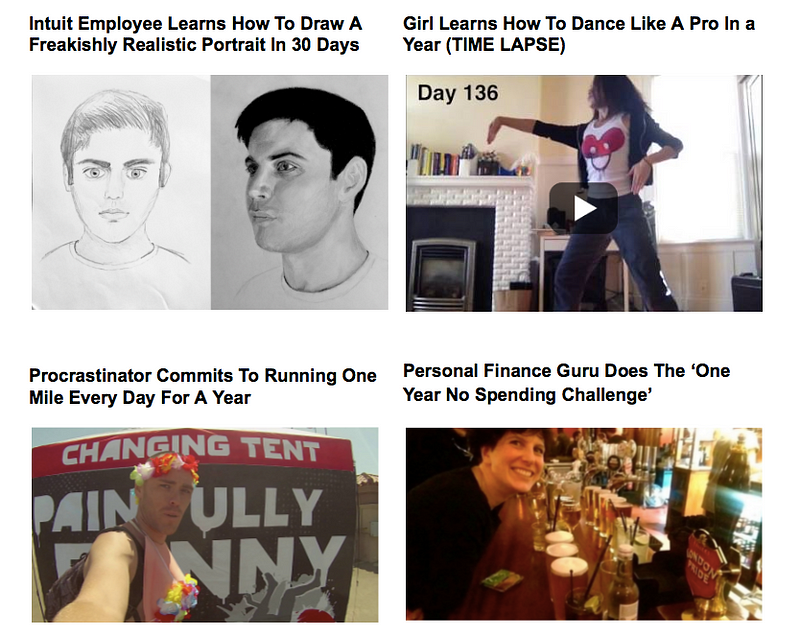
Source: To Become Who You Want To Be, Try These 15 Life Experiments
Understanding The Math: If You Can Do Enough Experiments, Success Is Virtually Guaranteed
If experimentation is so powerful, why don’t more people do it?
I say that there are a few reasons…
First, we live in a culture that is obsessed with productivity: getting more done and less time, systematizing, automating, and even outsourcing. If one has a frame of short-term productivity, then taking time out of your day to nurture a creative process with unpredictable results that don’t pay off immediately is extremely hard. What is productive in the long-term often feels not productive in the short-term.
Also, performing experiments is time intensive. To squeeze out some deliberate learning every day requires at least 15 minutes, but even more challenging is that most experiments fail. While failure is increasingly celebrated in our society, most people still have a visceral feeling of shame and disappointment that comes from it.
It wasn’t until I understood the math behind experimentation that I was able to get past my fear of failure.
1. If you do enough experiments, the odds are in your favor. The quality of each subsequent experiment increases because you will tend to apply the lessons learned from previous experiments. Those lessons make your success curve exponential rather than linear.
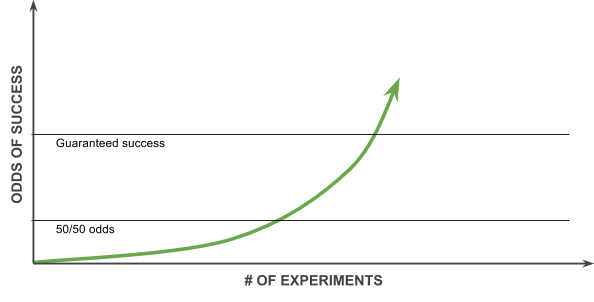
2. One big winner pays more than enough for all the losing experiments, as Jeff Bezos explained in a recent SEC filing:
Given a ten percent chance of a 100 times payoff, you should take that bet every time. But you’re still going to be wrong nine times out of ten. We all know that if you swing for the fences, you’re going to strike out a lot, but you’re also going to hit some home runs. The difference between baseball and business, however, is that baseball has a truncated outcome distribution. When you swing, no matter how well you connect with the ball, the most runs you can get is four. In business, every once in awhile, when you step up to the plate, you can score 1,000 runs.

Source: Nassim Taleb
3. Today’s tools allow anyone to increase their quantity of experimentation by an order of magnitude. A new breed of affordable apps, services, and trackers help us learn about what works for other people, collect data on ourselves, interpret it, stay accountable, and track our progress in real time. In the health space, for example, these new tools have led to the biohacking and quantified self-movements where people use blood glucose levels, sleep, activity, heart rate, gut biome, and genetics to facilitate their experimentation. Similar experimentation explosions are happening in the world of relationships, sexuality, intelligence, happiness, productivity, and personal finances.If so many people across so many fields can incorporate deliberate experimentation, so can you!
What We Can Learn From Edison About Actually Living the 10,000-Experiment Rule
Edison didn’t intend to just be more inventive. He created an experimentation factory to guarantee that he and his team consistently released new inventions. Edison’s goal, for example, was one minor invention every 10 days and one major invention every six months. When he was on the edge of a major breakthrough, such as the light bulb, he had a unique process called drag hunts in which he would generate and test hundreds, even thousands of possibilities.
So what could the 10,000-experiment lifestyle look like for you?
I recommend taking two steps now that could change everything for you.
First, identify at least one jackpot experiment that could change your life. The road to deliberate experimentation starts with one experiment, but not all experiments are created equal. Some experiments are extremely time and money intensive. Some create incremental changes, while others could be life changing. Some have a 1% chance of success. Others are a sure bet. When picking a first jackpot experiment to pursue, you want to pursue an experiment that is easy to do monetarily and timewise, has the potential to be life changing, and carries a reasonable probability of paying off. I call these Jackpot experiments.
Second, I recommend running three experiment tests each day. When you start the day, identify three tests you want to perform. Collect data throughout the day, and before the day ends, analyze the results.
Try this for one month, or 30 tests, and see the difference it makes!
Interested in really taking action to become a deliberate experimenter? After studying how dozens of the world’s most prolific experimenters work, we spent dozens of hours creating a free mini-course that includes several email lessons and a webinar to help you be successful with the 10,000-experiment rule. It includes case studies of experimenters who improved their health, confidence, and lifestyle, tips on how to perform a valid experiment, details on the nuances of Blind Variation And Selective Retention and much more.
Click here to sign up for the free course >>
Special thanks to Eben Pagan for reviewing the article and coining the phase ‘10,000-experiment rule.’
9 Creative Ways To Find Books That Will Make You A Genius

Time disappears. A new world reveals itself. The future will be different than the past because of the words you’ve read.


